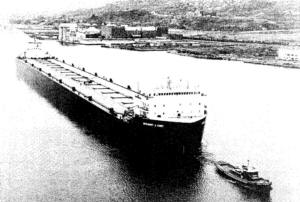Economic Drama of the Saginaw Valley Building Toward Inevitable Crescendo
|
||||||||||
| Printer Friendly Story View |

Channel Island at the mouth of the Saginaw River is a 285 acre enclosure created from dredged material that one day will become part of Bay County. Some say it would be an ideal spot for a wind energy farm.

Thirteen 1,000 foot long super carriers like this first one, the Stewart J. Cort, have transformed Great Lakes shipping.
(EDITOR'S NOTE: "Business as usual" won't calm the current economic storm. Problems not faced squarely often become overwhelming. We urge individuals and organizations to avoid the denial trap and launch creative thinking and bold entrepreneurial action toward revitalizing the local economy.)
The tectonic economic shifts of the past three decades are building toward a cataclysmic conclusion in the Saginaw Valley.
Whether the sound created will be beautiful music or a resounding thud is yet to be determined. However, the crescendo is no doubt coming soon.
Lay it on the line: Local populations are shrinking, higher education levels are half the state average, new jobs and wages are puny, property taxes are too high. On and on.
Obviously, the Saginaw Valley and tri-county area are in a transitional economy like that faced when the forests ran out and the lumber mills closed 100 years ago.
Over 30 years massive smokestack industries have fallen: Defoe Shipbuilding . . . American Hoist . . . Prestolite . . . Saginaw Foundry . . . Flint's Buick City.
The former Saginaw Steering Gear, now Delphi Corporation, is tottering like an elephant pierced with hundreds of arrows.
The future of 90-year-old Bay City GM PowerTrain is uncertain; half the employees have opted for buyouts. Huge parking lots are often empty.
Historic shifts are in the wind, international trends determining the fate of the U.S. auto industry, workers and families. Bottom line: the whole fabric of local society is at risk.
Bay City officials lament inability to make needed budget cuts. Property taxes are too high to spark growth, but they can't find a soft landing.
Saginaw River shipping seems immune to economic trends. Huge freighters 1,000 feet long haul millions of tons of coal, stone, salt and other bulk products to dozens of terminals.
Of the seven improved harbors on the east coast of the lower peninsula and the western end of Lake Erie, only the Saginaw River, the Rouge River and Toledo can handle larger lakes vessels. The Saginaw is second in tonnage behind Detroit.
The massive Karn-Weadock complex of Consumers Energy at the river mouth produces a third of the firm's output, fueled mainly by low sulfur coal from the west. The complex is key: it is valued at $240 million for tax purposes and pays about $9 million a year to local governmental units and schools, including about $2 million to the county, says County Executive Thomas L. Hickner.
The river is our lifeblood, some say our future. But even that thriving part of the economy is threatened. The river is so low the leviathans can't turn and often must back all the way to Saginaw Bay.
Congress has refused to fund added dredging to the U.S. Army Corps of Engineers. Three of four ships come in with short loads because of low water. Each inch of lost draft equals about 270 tons of super carrier cargo. That means loss of millions of dollars and fewer jobs in the area.
Worse than that: low water levels and lack of dredging threaten the ability of shippers to meet the coal-generated energy needs of the entire Great Lakes basin, says Fred L. Shusterich, president of Midwest Energy Resource Co., Superior, Wisconsin.
Super carriers are losing as much as 18 inches of loaded draft and the Saginaw River is said to be about 60 inches short of needed levels. Wonder why your energy bills are skyrocketing? Look to Washington, which has other priorities for tax dollars. The $200 million needed to restore the Great Lakes to project depths is a drop in the Iraq war bucket, but we can't squeeze even that drop. Congress needs to act for once in the interest of the people of Michigan and the Midwest.
Economic developers remain in denial about economic trends. A recent seminar in Bay City was critical of organizations for failure to unify. Instead of facing key issues they grope for easy answers to a potential economic revival. Some leaders seem paralyzed with fear, afraid to say or do anything. It is the "deer in the headlights" factor, often disastrous.
The main strategy focuses on entertainment, tourism, luxury condominiums, hotels, boutiques and "cool city" amenities. Hope is tourism will replace the economy provided for the past century by solid blue collar factory jobs. Stupendous events like Tall Ships show the strategy may work.
Unions have fallen out of favor, but realists know the $25 per hour jobs that local businesses took for granted will not be replaced by waiters' wages even if every family has two earners.
Consultants parade by, each grasping for a viable approach. The path to a new economy for this area is not clear and searching for it with consultants is a costly method, akin to seeking the proverbial needle in the haystack.
Some aspects of economic diversification away from factory smokestacks have long been in the works.
Frankenmuth leads in tourism with buses disgorging senior citizen flocks to devour chicken in massive restaurants like Zehnders serving over a million meals a year. Three million visitors annually to Frankenmuth whet the appetites of every local business maven for miles around. A new Zehnders Waterpark Hotel draws happily splashing kids and recreating parents comprising the majority of the more than 100,000 visitors a year paying premium room rates.
Even industry-rich Midland has the tourism-entertainment fever, dipping into its mega-million dollar foundations fed by two of the nation's blue ribbon firms, the Dow Chemical Company and Dow Corning Corporation. Now a baseball stadium is rising on the site of the old 47 Building, longtime lair of Dow's button-down executives.
About $30 million that Bay City couldn't, or wouldn't, come up with is funding a new tri-county baseball team. Lansing, Grand Rapids and Traverse City have one: why not here?
Developers salivate over the word "casino," greedily eying the bonanza of about $600 million a year created by the Soaring Eagle of the Chippewa Tribe in Mt. Pleasant. No one asks the question: when will the golden goose stop laying eggs? One answer: Probably when the industrial pensioners of mid-Michigan, the main casino patrons from Saginaw, Bay City, Flint, Grand Rapids, Lansing, and rural enclaves in between, lose all their money or die.
Besides, the Chippewa with mega-bucks lobbying power, would no doubt look askance at any competing casino within 100 miles. The fact of life is that votes can be bought, proven in Washington every day. The tribe has the cash to squash gambling competitors and even to sue to get their land back. That thrust is just getting underway in Federal Court in Bay City.
Cash-strapped Bay County politicians covet the lifeblood of the only proven development strategy, skimming off a percentage of property taxes under a device known as Tax Increment Financing (TIF).
Mumbled criticism about "philosophical differences" is heard of so-called "Downtown Development Authority," organizations with separate management set up to manage the taxes "captured" from government.
Some $21 million has been shifted from government control to what critics call "private interests" in the past ten years.
Downtown Bay City has built and thrived on this structure for two decades; backers say downtown may have "died" without it. The fountain in the new Waterfall Park would not be bubbling were it not for the Bay City DDA and its TIF financing, capturing taxes from downtown businesses.
About 20 industries and 1,000 jobs have been created or saved by moving companies to Valley Center Technology Park at US-10 and Mackinaw Road in Monitor Township. Most originated in this area, but a few sought the cheap land and infrastructure improvements provided by the tax dollars.
Other townships like Hampton and Williams see such tax increment financing as indispensable to growth and want to launch TIF financed industrial parks, but politicians are discouraging them while they quietly dismantle the process.
Unless companies and investors come forward to provide the capital up front, potential developments may not happen, backers of TIFs say. Jobs, population and tax base provided by employees buying homes here will ultimately be lost. Some government leaders think DDA's skim taxes to create developments that never come on the tax rolls. They feel government can use TIF money to better effect in economic development.
This debate may degenerate into self-destructive finger pointing further depressing growth. Kind of like the argument that we don't want unions but we want union level wages to support businesses, services and governments.
Ann Arbor, now "Googled" with a potential 1,000 new high-paying jobs, has about half its adult population with four-year degrees. Old industrial towns like Bay City, Saginaw and Flint don't have the higher education culture. U.S. Census figures for 2005 show Bay County with 12.8 percent of its adults with four year degrees; the state average is 24 percent.
If taxes are the problem, maybe they're also the answer, says one longtime local economic promoter. He is floating an idea for a small retail sales tax hike, say 1 percent, to create a fund, bolstered by donations, to pay for university educations for local kids.
The idea is currently being pondered by the local "powers that be." The added sales tax would not be placed on automobiles.
A "Kalamazoo Promise" approach may be the saving grace of this area, says the longtime successful entrepreneur. If Ann Arbor futurist Lou Glazer is right and a college-educated population is the key to growth, why not prime the pump?
"The Bay County Promise": Do we hear cash registers and college bells ringing? Or will the "deer in the headlights" factor persist?
Tell us what you think.###
| Printer Friendly Story View |
|
|

Dave Rogers |
|
|
|
Printer-Friendly Story View
0200 Nd: 04-22-2024 d 4 cpr 0
12/31/2020 P3v3-0200-Ad.cfm
SPONSORED LINKS
12/31/2020 drop ads P3v3-0200-Ad.cfm


